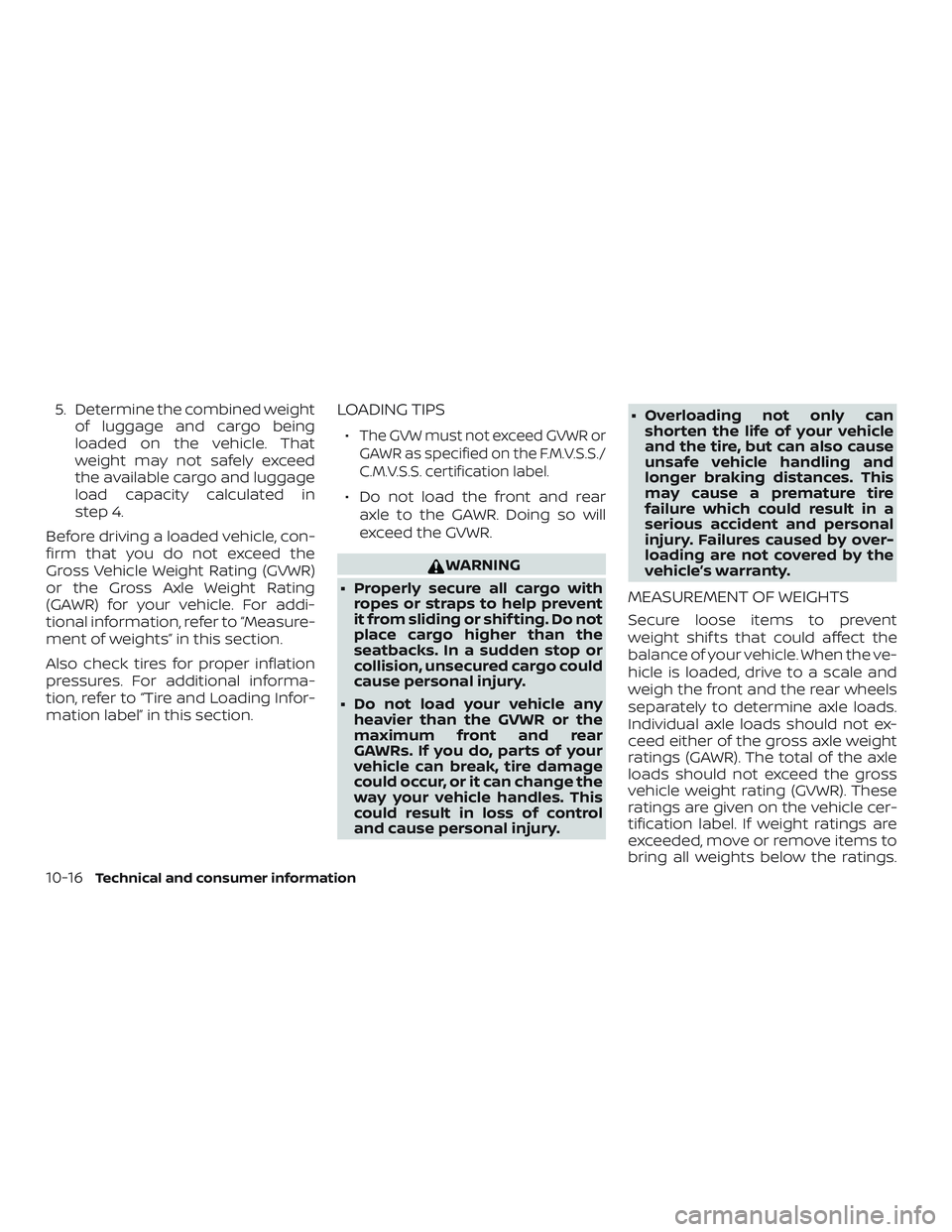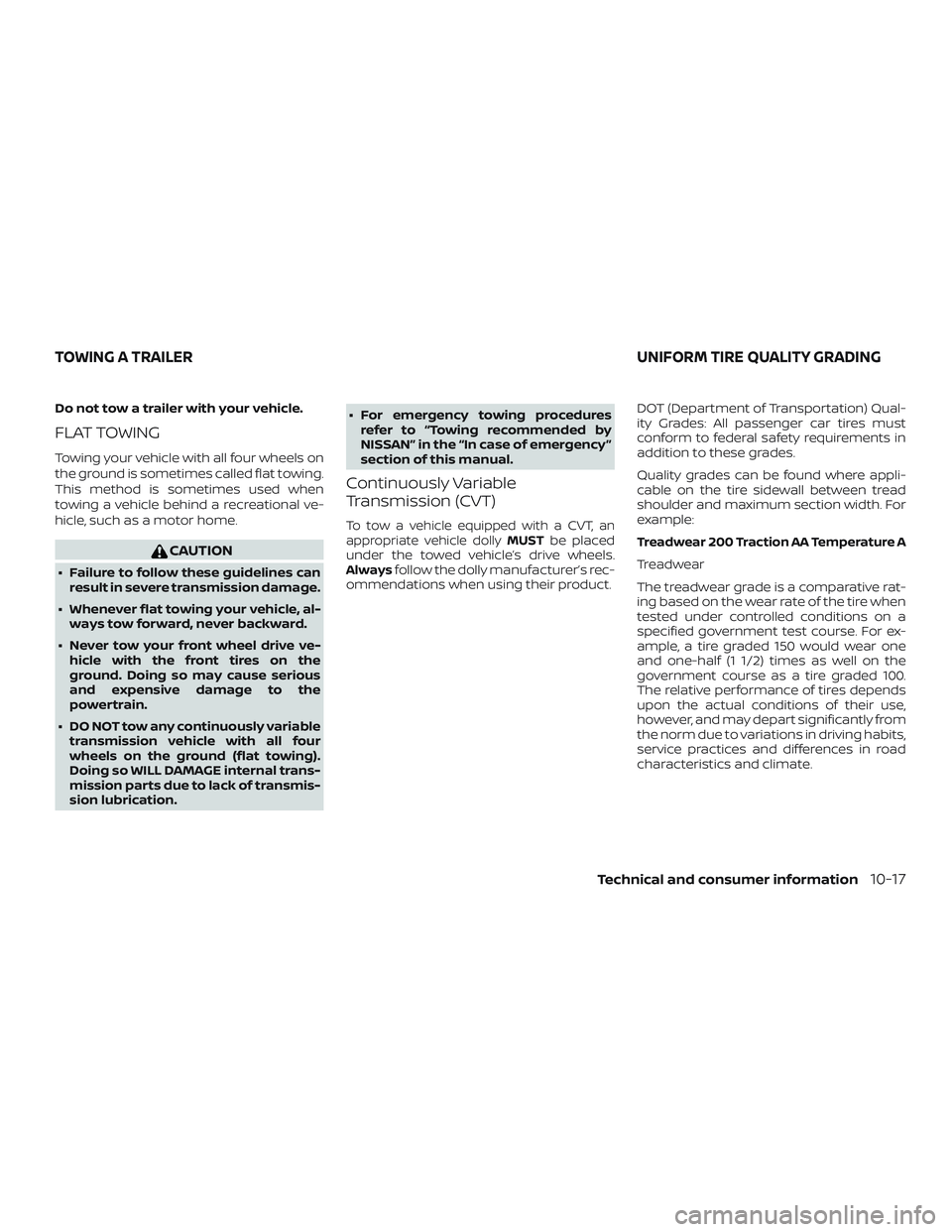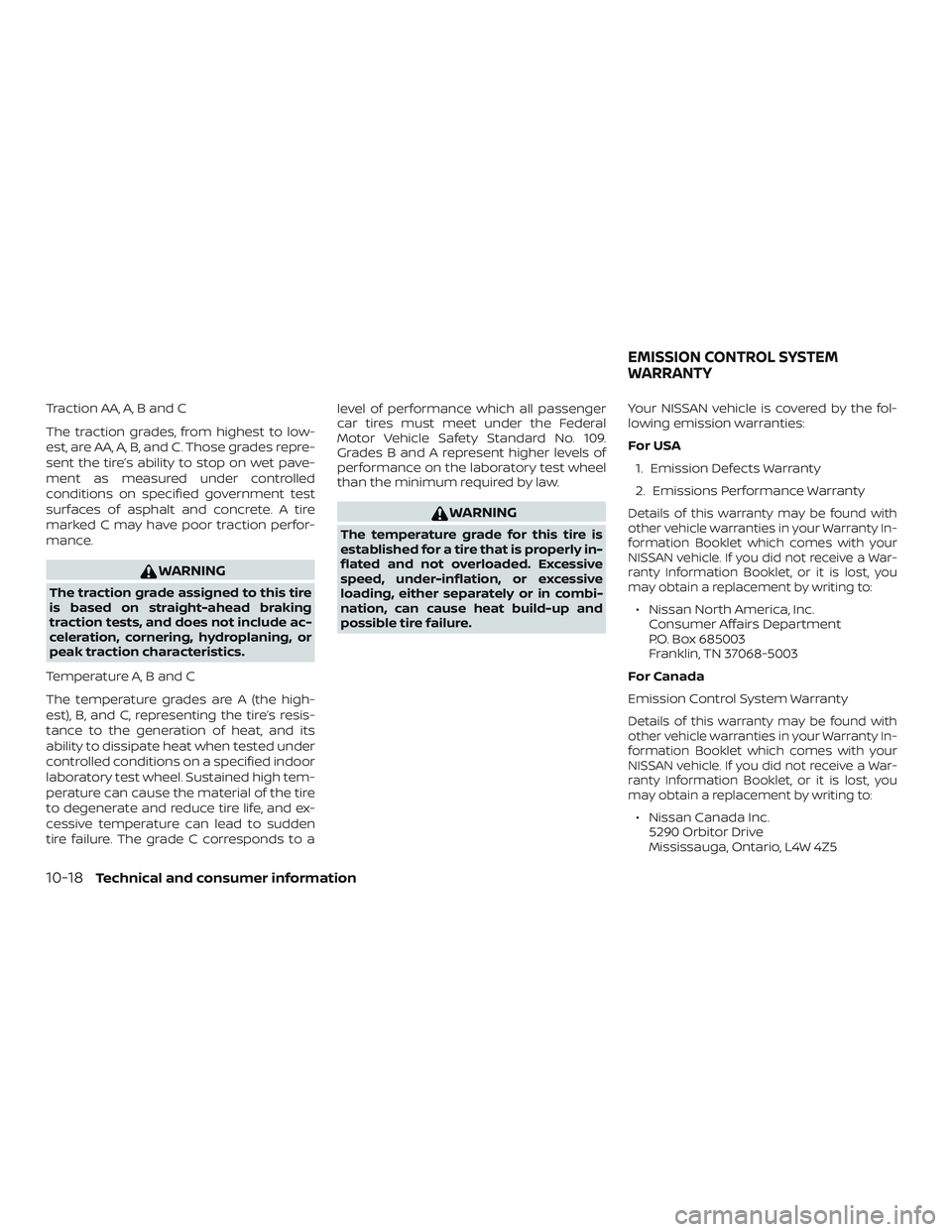2019 NISSAN ALTIMA wheel
[x] Cancel search: wheelPage 543 of 592

WHEELS AND TIRES
Wheel typeSizeOffset in
(mm)
Steel 16 x 7.0J1.77 (45)
Aluminum 17 x 7.5J1.97 (50)
Aluminum 19 x 8.0J 2.17 (55)
T-type (Steel spare) 16 x 4T1.18 (30)
Tire size
2.5 S model P215/60R16
2.5 SV/SL models P215/55R17
2.5 and 2.0 SR/Platinum models P235/40R19
Spare tire T135/70D16
T135/90D16
DIMENSIONS AND WEIGHTS
Unit: in (mm)
Overall length without license plate bracket 192.9 (4,900)
Overall width without mirrors 72.9 (1,852)
Overall height at Base Curb Weight to Roof Metal 2.5 L with front wheel drive USA S model 56.7 (1,440)
Canada S model 56.7 (1,441)
USA SV 56.9 (1,444)
Canada SV 56.9 (1,445)
USA / Canada SL models 56.9 (1,444)
USA Platinum model 56.9 (1,445)
Canada Platinum model 56.9 (1,446)
USA SR model 56.9 (1,444)
Canada SR model 56.9 (1,445)
with All-wheel drive USA / Canada S model 57.2 (1,452)
USA / Canada SV and SL models 57.3 (1,456)
USA / Canada Platinum model 57.4 (1,459)
USA SR model 57.4 (1,458)
Canada SR model 57.4 (1,459)
2.0 L USA Platinum model 56.9 (1,445) Canada Platinum model 56.9 (1,446)
USA SR 56.8 (1,443)
Canada SR 56.9 (1,444)
Front and Rear track 16 inch wheel 63.6 (1,615)
17 inch wheel 63.2 (1,605)
19 inch wheel 62.8 (1,595)
Wheelbase 111.2 (2,825)
Gross vehicle weight rating lbs. (kg) Refer to the “F.M.V.S.S./C.M.V.S.S. certification label” on the centerpillar between the driver’s side front and rear doors.
Gross axle weight rating
Front lbs. (kg)
Rear lbs. (kg)
Technical and consumer information10-9
Page 550 of 592

5. Determine the combined weightof luggage and cargo being
loaded on the vehicle. That
weight may not safely exceed
the available cargo and luggage
load capacity calculated in
step 4.
Before driving a loaded vehicle, con-
firm that you do not exceed the
Gross Vehicle Weight Rating (GVWR)
or the Gross Axle Weight Rating
(GAWR) for your vehicle. For addi-
tional information, refer to “Measure-
ment of weights” in this section.
Also check tires for proper inflation
pressures. For additional informa-
tion, refer to “Tire and Loading Infor-
mation label” in this section.LOADING TIPS
∙The GVW must not exceed GVWR or
GAWR as specified on the F.M.V.S.S./
C.M.V.S.S. certification label.
∙ Do not load the front and rear axle to the GAWR. Doing so will
exceed the GVWR.
WARNING
∙ Properly secure all cargo with ropes or straps to help prevent
it from sliding or shif ting. Do not
place cargo higher than the
seatbacks. In a sudden stop or
collision, unsecured cargo could
cause personal injury.
∙ Do not load your vehicle any heavier than the GVWR or the
maximum front and rear
GAWRs. If you do, parts of your
vehicle can break, tire damage
could occur, or it can change the
way your vehicle handles. This
could result in loss of control
and cause personal injury. ∙ Overloading not only can
shorten the life of your vehicle
and the tire, but can also cause
unsafe vehicle handling and
longer braking distances. This
may cause a premature tire
failure which could result in a
serious accident and personal
injury. Failures caused by over-
loading are not covered by the
vehicle’s warranty.
MEASUREMENT OF WEIGHTS
Secure loose items to prevent
weight shif ts that could affect the
balance of your vehicle. When the ve-
hicle is loaded, drive to a scale and
weigh the front and the rear wheels
separately to determine axle loads.
Individual axle loads should not ex-
ceed either of the gross axle weight
ratings (GAWR). The total of the axle
loads should not exceed the gross
vehicle weight rating (GVWR). These
ratings are given on the vehicle cer-
tification label. If weight ratings are
exceeded, move or remove items to
bring all weights below the ratings.
10-16
Technical and consumer information
Page 551 of 592

Do not tow a trailer with your vehicle.
FLAT TOWING
Towing your vehicle with all four wheels on
the ground is sometimes called flat towing.
This method is sometimes used when
towing a vehicle behind a recreational ve-
hicle, such as a motor home.
CAUTION
∙ Failure to follow these guidelines canresult in severe transmission damage.
∙ Whenever flat towing your vehicle, al- ways tow forward, never backward.
∙ Never tow your front wheel drive ve- hicle with the front tires on the
ground. Doing so may cause serious
and expensive damage to the
powertrain.
∙ DO NOT tow any continuously variable transmission vehicle with all four
wheels on the ground (flat towing).
Doing so WILL DAMAGE internal trans-
mission parts due to lack of transmis-
sion lubrication. ∙ For emergency towing procedures
refer to “Towing recommended by
NISSAN” in the “In case of emergency ”
section of this manual.
Continuously Variable
Transmission (CVT)
To tow a vehicle equipped with a CVT, an
appropriate vehicle dolly MUSTbe placed
under the towed vehicle’s drive wheels.
Alwaysfollow the dolly manufacturer’s rec-
ommendations when using their product. DOT (Department of Transportation) Qual-
ity Grades: All passenger car tires must
conform to federal safety requirements in
addition to these grades.
Quality grades can be found where appli-
cable on the tire sidewall between tread
shoulder and maximum section width. For
example:
Treadwear 200 Traction AA Temperature A
Treadwear
The treadwear grade is a comparative rat-
ing based on the wear rate of the tire when
tested under controlled conditions on a
specified government test course. For ex-
ample, a tire graded 150 would wear one
and one-half (1 1/2) times as well on the
government course as a tire graded 100.
The relative performance of tires depends
upon the actual conditions of their use,
however, and may depart significantly from
the norm due to variations in driving habits,
service practices and differences in road
characteristics and climate.
TOWING A TRAILER
UNIFORM TIRE QUALITY GRADING
Technical and consumer information10-17
Page 552 of 592

Traction AA, A, B and C
The traction grades, from highest to low-
est, are AA, A, B, and C. Those grades repre-
sent the tire’s ability to stop on wet pave-
ment as measured under controlled
conditions on specified government test
surfaces of asphalt and concrete. A tire
marked C may have poor traction perfor-
mance.
WARNING
The traction grade assigned to this tire
is based on straight-ahead braking
traction tests, and does not include ac-
celeration, cornering, hydroplaning, or
peak traction characteristics.
Temperature A, B and C
The temperature grades are A (the high-
est), B, and C, representing the tire’s resis-
tance to the generation of heat, and its
ability to dissipate heat when tested under
controlled conditions on a specified indoor
laboratory test wheel. Sustained high tem-
perature can cause the material of the tire
to degenerate and reduce tire life, and ex-
cessive temperature can lead to sudden
tire failure. The grade C corresponds to a level of performance which all passenger
car tires must meet under the Federal
Motor Vehicle Safety Standard No. 109.
Grades B and A represent higher levels of
performance on the laboratory test wheel
than the minimum required by law.
WARNING
The temperature grade for this tire is
established for a tire that is properly in-
flated and not overloaded. Excessive
speed, under-inflation, or excessive
loading, either separately or in combi-
nation, can cause heat build-up and
possible tire failure.
Your NISSAN vehicle is covered by the fol-
lowing emission warranties:
For USA
1. Emission Defects Warranty
2. Emissions Performance Warranty
Details of this warranty may be found with
other vehicle warranties in your Warranty In-
formation Booklet which comes with your
NISSAN vehicle. If you did not receive a War-
ranty Information Booklet, or it is lost, you
may obtain a replacement by writing to:
∙ Nissan North America, Inc. Consumer Affairs Department
P.O. Box 685003
Franklin, TN 37068-5003
For Canada
Emission Control System Warranty
Details of this warranty may be found with
other vehicle warranties in your Warranty In-
formation Booklet which comes with your
NISSAN vehicle. If you did not receive a War-
ranty Information Booklet, or it is lost, you
may obtain a replacement by writing to:
∙ Nissan Canada Inc. 5290 Orbitor Drive
Mississauga, Ontario, L4W 4Z5
EMISSION CONTROL SYSTEM
WARRANTY
10-18Technical and consumer information
Page 554 of 592

WARNING
A vehicle equipped with All -Wheel Drive
(AWD) should never be tested using a
two wheel dynamometer (such as the
dynamometers used by some states for
emissions testing), or similar equip-
ment. Make sure you inform the test fa-
cility personnel that your vehicle is
equipped with AWD before it is placed
on a dynamometer. Using the wrong
test equipment may result in drivetrain
damage or unexpected vehicle move-
ment which could result in serious ve-
hicle damage or personal injury.
Due to legal requirements in some states
and Canadian Provinces, your vehicle
may be required to be in what is called
the “ready condition” for an Inspection/
Maintenance (I/M) test of the emission
control system.
The vehicle is set to the “ready condition”
when it is driven through certain driving
patterns. Usually, the ready condition can
be obtained by ordinary usage of the ve-
hicle. If a powertrain system component is re-
paired or the battery is disconnected, the
vehicle may be reset to a “not ready” condi-
tion. Before taking the I/M test, check the
vehicle’s inspection/maintenance test
readiness condition. Place the ignition
switch in the ON position without starting
the engine. If the Malfunction Indicator
Light (MIL) comes on steady for 20 seconds
and then blinks for 10 seconds , the I/M test
condition is “not ready”. If the MIL does not
blink af ter 20 seconds, the I/M test condi-
tion is “ready”. It is recommended that you
visit a NISSAN dealer to set the “ready con-
dition” or to prepare the vehicle for testing.
This vehicle is equipped with an EDR. The
main purpose of an EDR is to record, in
certain collision or near collision-like situa-
tions, such as an air bag deployment or
hitting a road obstacle, data that will assist
in understanding how a vehicle’s systems
performed. The EDR is designed to record
data related to vehicle dynamics and
safety systems for a short period of time,
typically 30 seconds or less. The EDR in this
vehicle is designed to record such data as:
∙ How various systems in your vehicle were operating;
∙ Whether or not the driver and passen- ger safety belts were buckled/fastened;
∙ How far (if at all) the driver was depress- ing the accelerator and/or brake pedal;
and,
∙ How fast the vehicle was traveling.
∙ Sounds are not recorded.
READINESS FOR INSPECTION/
MAINTENANCE (I/M) TEST EVENT DATA RECORDERS (EDR)
10-20Technical and consumer information
Page 557 of 592

11 Index
A
Active noise cancellation Active sound
enhancement ..........5-184,5-184
ActiveRideControl(ARC)..........5-175
Air bag (See supplemental restraint
system) .................... .1-46
Air bag system Front (See supplemental front impact
airbagsystem)..............1-53
Airbagwarninglight..........1-66, 2-15
Air bag warning light,
supplemental ..............1-66, 2-15
Air cleaner housing filter ..........8-19
Air conditioner Air conditioner operation ....4-32,4-38
Air conditioner specification label . .10-12
Air conditioner system refrigerant
and oil recommendations .......10-7
Air conditioner system refrigerant
recommendations ............10-7
Heater and air conditioner
controls...............4-29,4-38
Servicing air conditioner ........4-41
Air flow charts .................4-33
Alarm system
(See vehicle security system) .......2-39
All-Wheel Drive .............5-166,6-14
Anchor point locations ...........1-28
Antenna ....................4-42
Antifreeze ...................5-181 Anti-lock brake warning light
........2-10
Anti-lock Braking System (ABS) ......5-171
Armrests.................... .1-7
Audible reminders ..............2-18
Autolightswitch ...............2-44
Automatic Automatic drive
positioner ...........3-33,3-34,3-35
Automatic power window switch . . .2-61
Automatic anti-glare inside mirror . . . .3-32
Automaticbrakehold............5-28
Automatic door locks .............3-7
Automatic drive positioner . .3-33, 3-34, 3-35
Automatic Emergency Braking
(AEB) ................2-10,2-14,5-130
Automatic Emergency Braking (AEB) with
Pedestrian Detection ............5-139
AWD...................5-166,6-14
B
Battery .................5-181,8-15 Charge warning light ...........2-11
Battery replacement ............8-24
Keyfob...................8-24
NISSAN Intelligent Key® .........8-25
Before starting the engine .........5-16
Belt(Seedrivebelt)..............8-17
Blind Spot Warning (BSW) ..........5-45
Booster seats .................1-42
Brake Anti-lock Braking System (ABS) ....5-171 Brakefluid.................8-13
Brakelight(Seestoplight).......8-27
Brakesystem...............5
-170
Brakewarninglight............2-11
Brakewearindicators.......2-18,8-21
Parking brake operation ........5-25
Self-adjustingbrakes ..........8-21
Brake Assist ..................5-172
Brakefluid...................8-13
Brakes......................8-21
Brakesystem.................5 -170
Break-in schedule ..............5-164
Brightness control Instrument panel .............2-49
Bulb check/instrument panel .......2-10
Bulb replacement ..............8-27
C
Capacities and recommended
fuel/lubricants.................10-2
Ca
rgo
(See vehicle loading information) .....10-13
Car phone or CB radio ...........4-42
Chassis control ...............5 -175
Check tire pressure .............2-34
Childrestraints.......1-21, 1-22, 1-23, 1-26 LATCH (Lower Anchors and Tethers for
CHildren)System.............1-26
Precautions on child
restraints.........1-23, 1-31, 1-38, 1-43
Page 559 of 592

Frontseats....................1-2
Fuel Capacities and recommended
fuel/lubricants...............10-2
Fuel economy ...............5-165
Fuel-filler door and cap ..........3-27
Fuel-filler door lock opener lever ....3-27
Fuel gauge ..................2-7
Fueloctanerating.............10-6
Fuel recommendation ..........10-4
Loose fuel cap warning .........2-34
Fuelefficientdrivingtips..........5-164
Fuel-filler door .................3-27
Fuel gauge ....................2-7
Fuses .......................8-22
Fusiblelinks...................8-23
G
Garage door opener, HomeLink® Universal
Transceiver ......2-66,2-68,2-69,2-69,2-70
Gascap.....................3-27
Gauge Engine coolant temperature gauge . .2-6
Fuel gauge ..................2-7
Odometer ..................2-5
Speedometer ..............2-4,2-5
Tachometer .................2-6
Trip odometer .............2-4,2-5
General maintenance .............9-3
Glovebox....................2-57
Gloveboxlock.................2-57 H
Hazard warning flasher switch ........6-2
Headlight and turn signal switch ......2-43
Headlightcontrolswitch...........2-43
Headlights ...................8-26
Headrestraints................. .1-7
Heated seat switches .............2-51
Heated steering wheel ............2-52
Heater Heater and air conditioner
controls................4-29,4-38
Heater operation ..........4-30,4-39
Hill start assist system ...........5-176
HomeLink® Universal
Transceiver ......2-66,2-68,2-69,2-69,2-70
Hood ...................... .3-24
Horn.......................2-50
I
Ignition switch Push-button ignition switch .......5-13
Immobilizer system ..........2-40,5-16
Important vehicle information label . . . .10-11
In-cabinmicrofilter ..............8-19
Increasing fuel economy ..........5-165
Indicator NISSAN Intelligent Key® battery discharge
indicator...................5-15
Indicator lights and audible reminders
(See warning/indicator lights and audible
reminders) ....................2-15
Inside automatic anti-glare mirror .....3-32
Instrument brightness control .......2-49Instrument panel
.............0-6,2-2
Instrument panel dimmer switch .....2-49
Intelligent Around View Monitor .......4-11
Intelligent Cruise Control (ICC)
(for vehicles without ProPILOT Assist) . . .5-67
Intelligent Cruise Control (ICC)
(for vehicles with ProPILOT Assist) ....5-103
Intelligent Driver Alertness (I-DA) .....5-160
Intelligent Forward Collision Warning
(I-FCW).....................5-148
Intelligent Key system Key operating range ............3-9
Key operation ................3-10
Mechanical key ...............3-3
Remote keyless entry operation ....3-14
Troubleshooting guide ..........3-18
W
arning signals ..............3-18
Intelligent Lane Intervention (I-LI) .....5-39
Intelligent Trace Control (I-TC) .......5-175
Interiorlight...................2-64
Interiortrunklidrelease...........3-26
ISOFIX child restraints .............1-26
J
Jumpstarting...............6-9,8-16
K
Key........................ .3-2
Key fob battery replacement ........8-24
Keyless entry With Intelligent Key system
(See Intelligent Key system) .......3-14
11-3
Page 562 of 592

Armrests ...................1-7
Automatic drive
positioner ...........3-33,3-34,3-35
Frontseats..................1-2
Manual front seat adjustment ......1-3
Rearseat...................1-5
Security indicator light ............2-17
Security system (NISSAN Vehicle Immobilizer
System), engine start ..........2-40,5-16
Security systems Vehicle security system .........2-39
Self-adjustingbrakes.............8-21
Service manual order form .........10-22
Servicing air conditioner ...........4-41
Shif ting Continuously Variable Transmission
(CVT) .....................5-20
Shiftleverlockrelease............5-23
Shoulder belt height adjustment ......1-19
Sonar Rear system ................5-176
Spark plug replacement ...........8-18
Spark plugs ...................8-18
Specifications .................10-8
Speedometer ................2-4,2-5
Speedometer and odometer ........2-4
Spotlights(Seemaplight)..........2-65
SRS warning label ...............1-66
Stability control ................5-172
Standard maintenance ........9-10,9-15
Starting Before starting the engine ........5-16
Jumpstarting.............6-9,8-16
Precautions when starting and
driving ..................5-4,5-11
Push starting ................6-11 Starting the engine
............5-17
Starting the engine ..............5-17
Steering Heated steering wheel ..........2-52
Powersteeringsystem.........5-169
Steering Assist switch
(forvehicleswithProPILOTAssist).....2-52
Steering wheel .................3-29
Stoplight....................8-27
Storage.....................2-56
Sunglasses case ................2-58
Sunglasses holder ..............2-58
Sunroof ......................7-5
Sunroof (see Moonroof ) ...........2-62
Sunvisors....................3-30
Supplemental air bag warning
light.................... .1-66, 2-15
Supplemental front impact air bag
system ..................... .1-53
Supplemental restraint system Information and warning labels . . . .1-66
Precautions on supplemental restraint
system ................... .1-46
Supplemental restraint system
(Supplemental air bag system) .......1-46
Switch Autolightswitch..............2-44
Automatic power window switch . . .2-61
Foglightswitch..............2-50
Hazard warning flasher switch ......6-2
Headlight and turn signal switch ....2-43
Headlightcontrolswitch.........2-43
Instrument brightness control .....2-49
Power door lock switch ..........3-6
Rear window and outside mirror
defrosterswitch..............2-43 Turn signal switch
.............2-49
T
Tachometer ...................
2-6
Temperature gauge Engine coolant temperature gauge . .2-6
Thef t (NISSAN Vehicle Immobilizer System),
engine start ...............2-40,5-16
Three-waycatalyst...............5-4
Tilt Telescopicsteering............3-30
Tire Flattire..................6-3,6-4
Spare tire ...............6-5,8-42
Tire and Loading Information label . .10-12
Tire chains .................8-37
Tire pressure ................8-30
Tirerotation ................8-39
Types of tires ................8-36
Uniform tire quality grading .......10-17
Wheels and tires ..............8-30
Wheel/tire size ...............10-9
Tire pressure Low tire pressure warning light .....2-12
Tire Pressure Monitoring System
(TPMS)....................5-5,6-3
Towing 4-wheel drive models ...........6-13
Flattowing.................10-17
Trailertowing ...............10-17
Towingatrailer................10-17
Towingyourvehicle..............6-12
Traffic Sign Recognition (TSR) ........5-31
11-6